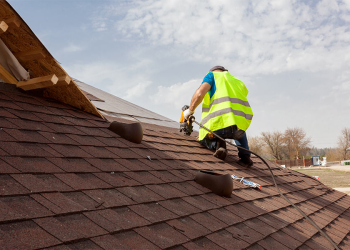Fireplaces can range from a necessity to a room piece that is completely disposable. Regardless of how they are used, fireplaces require chimneys and the chimneys themselves can cause serious health and safety issues if they are not cared for properly. Why? Let’s look at some reasons to keep chimney cleaning at the top of your priority list.
Next, it is extremely important to understand that each time a fire is burned, the smoke rises through the chimney and causes a buildup called creosote. When the smoke and fire hit the walls of the chimney, they will eventually start to get caked with creosote. As the creosote builds, you will be able to identify it as a sticky, black substance inside of your chimney, and possibly fireplace. The problem with creosote buildup is that it is highly flammable, noxious, and has been known to be the cause of massive house fires.
According to OhioMasonryRepair.com located in Columbus, Ohio, It has been shown that only 1/4” to 1/8” of creosote is needed to start a significant fire within your chimney that can cause major home damage. The worst case scenario for creosote, is when it is classified as stage 3, which means that the creosote is at its most dangerous, concentrated, and flammable level. Remember that creosote is an issue of build up, which means it will build and cake into a thick, dangerous layer inside your chimney.
Creosote is not the only thing that can build up inside of your chimney and cause hazards. Dirt and ash accumulate inside of the chimney’s flue as well as creosote and carry hazards of their own. Dirt in itself can cause allergy issues and hazardous build up of its own that can cause flammable debris. Ash can also cause dusty messes and create breathing issues or coughing. If a chimney is too caked by dirt and ash, smoke can billow out backwards into your home and also cause the air to become noxious. The utmost important worry being that of carbon monoxide poisoning, since massive buildup or clogging inside of the chimney can cause carbon monoxide to form – especially when smoke is coming backward into the home instead of out. Carbon monoxide, being odorless, is hard to detect with regular human senses, so excessive smoke could be your only warning.
One reason to keep an eye on that chimney that some might find surprising – is water damage. Chimneys have liners to protect them from water damage and ensure a tight seal to protect the chimney and fireplace. If these liners wear down, or if they begin to crack, water can cause your chimney to change color on the outside and even wear down your fireplace on the inside. Having this issue can also allow smoke to enter your home itself as well cause odors of moisture or mold. While water damage isn’t a hard problem to recognize, extensive water damage can become a hard problem to remedy. Routine maintenance to check for water damage is the best advice anyone could give when looking into protecting your home from outside elements.
Another reason to maintain your chimney and fireplace is to ensure that it is working efficiently. Blockages in the system can cause oxygen levels to be lower, which means fires will be weaker or smaller if the air cannot pass through. Weak fires mean low heat, and if your chimney is not cleared and cleaned, it will not be able to produce the heat you desire, or even enough heat to cover the desired areas. This can lead to cold fingers, frosted toes, and busted water pipes. A clear, clean system is the best way to get maximum heat within your home.
Speaking of heat, animals are attracted to chimneys because the heat creates warmth for them and issues a sense of security with a tight space to nest or hide in. The biggest problem with this, is that most animals will build nests within your chimney, and some even inside the liner. This will not only cause blockages, but it can also cause odors and debris as well. If you are suspecting that you have an animal inside of your chimney (or walls!) you can call your local wildlife office for resources on trapping and removing the animals. There are also humane traps available for purchase and use that go on top of your chimney and prevent most animals from gaining access. This is another reason to check all parts of your chimney on a regular basis. As mentioned above, animals can gain access to live inside of your walls if they have regular access to your chimney.
Last but not least on this list of reasons is that keeping your fireplace’s anatomy up to date will save you precious time and money. Every homeowner knows that over time, homes wear down and it is important to inspect things every now and again. By having your chimney inspected, issues or problems can be detected in their earlier stages. Once these issues have time to develop and take a toll on the structures involved, they can become worse, causing even bigger and more expensive damages to be repaired.
By now, it is obviously no secret that chimneys need routine cleaning and that it can cause detrimental problems when not dealt with, inside and outside of your home. That means, that sometimes the simple act of putting your routine chimney cleaning on the to-do list for periodic maintenance may not be enough to keep your household free of hazards. This can depend on how hot your fires burn, how often, and what kind of wood is burned within your fireplace. As a preventative notation, here are some signs that your chimney has problems and/or needs to be cleaned right away:
- Smoke buildup during a fire
- Hearing animals inside of the walls
- Easily noticing creosote buildup is present
- Weak, or poor burning fires
- Strong odors coming from the chimney and fireplace
If any of the above problems arise, or you notice that your chimney seems to be dirtier than usual, you are urged to contact a professional right away to have it thoroughly cleaned and inspected. Even if no major problems are found, it is better to be safe than sorry!
Lastly, there are definitely some old wives tales out there about cleaning chimneys yourself and they range from burning aluminum cans in an extremely hot fire, to throwing potato skins or salt into your fires. While they may be effective for smaller systems, they are not recommended. Both have been shown to be valid to a degree, but they do not clean or clear your chimney completely. Each method here only clears small amounts of creosote and will not guarantee any safety or cleanliness of your chimney.
It is also important to note that while chimney sweeping logs are available, they do not always work either. Chimney sweeping logs do contain a chemical that will breakdown creosote, but reports show that even these logs only clear about 60% of creosote – with repeated use. In reports from different articles on the matter, Duraflame logs themselves, have been shown to build up moisture on the walls inside of your fireplace and chimney. Here again, we run into the issue of possible water damage and lingering odors. That being said, it is probably better to call in the professionals instead of relying on these logs too often seeing that creosote is the most dangerous buildup to worry about in this situation.
However, it has been said by a good amount chimney sweeping professionals that significant inlets of air at least twice a day, can indeed, help prevent some of the creosote build up that occurs and clear small debris from your liner and cap. This can also help you detect any blockages or stuck parts that may be present as you can assess the amount of air coming in or out of your system.
Overall, the importance of cleaning your chimney is something you want to keep on your to-do list at least twice a year. There are several professional companies available to do the chore for you, however you can purchase the tools in order to do it yourself. DIY is not recommended though, because it can be hard to ensure you have cleaned the chimney entirely if you don’t have a lot of knowledge behind it’s architecture. Chimney sweeping professionals are trained to clean your system thoroughly with tools designed to do the job, and they can let you know of any issues they find. Most, if not osme, can even help with resources on how to go about fixing the problems at hand.
If you are unsure of whether or not your chimney is safe, or you want to make sure it is up to code, you can contact the National Fire Protection Association (NFPA) and find out more information on how to receive an inspection from a professional.
Hey, Just one more thing, We’re actively looking for expert to contribute to home decor submit guest post, If you’re Interested, Please contact us!








